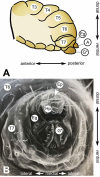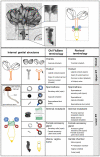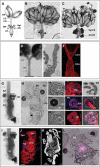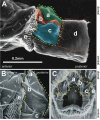A standardized nomenclature and atlas of the female terminalia of Drosophila melanogaster
- PMID: 35575031
- PMCID: PMC9116418
- DOI: 10.1080/19336934.2022.2058309
A standardized nomenclature and atlas of the female terminalia of Drosophila melanogaster
Abstract
The model organism Drosophila melanogaster has become a focal system for investigations of rapidly evolving genital morphology as well as the development and functions of insect reproductive structures. To follow up on a previous paper outlining unifying terminology for the structures of the male terminalia in this species, we offer here a detailed description of the female terminalia of D. melanogaster. Informative diagrams and micrographs are presented to provide a comprehensive overview of the external and internal reproductive structures of females. We propose a collection of terms and definitions to standardize the terminology associated with the female terminalia in D. melanogaster and we provide a correspondence table with the terms previously used. Unifying terminology for both males and females in this species will help to facilitate communication between various disciplines, as well as aid in synthesizing research across publications within a discipline that has historically focused principally on male features. Our efforts to refine and standardize the terminology should expand the utility of this important model system for addressing questions related to the development and evolution of animal genitalia, and morphology in general.
Keywords: Drosophila melanogaster; Genitalia; anatomy; nomenclature; terminalia.
Conflict of interest statement
No potential conflict of interest was reported by the authors.
Figures






References
-
- Eberhard WG. Sexual selection and animal genitalia. Cambridge Massachusetts USA: Harvard University Press; 1985.
-
- Hosken DJ, Stockley P. Sexual selection and genital evolution. Trends Ecol Evol. 2004;19(2):87–93. - PubMed
-
- Simmons LW. Sexual selection and genital evolution. Austral Entomol. 2014;53(1):1–17.
-
- Eberhard WG. Evolution of genitalia: theories, evidence, and new directions. Genetica. 2010;138(1):5–18. - PubMed
Publication types
MeSH terms
Grants and funding
LinkOut - more resources
Full Text Sources
Molecular Biology Databases
